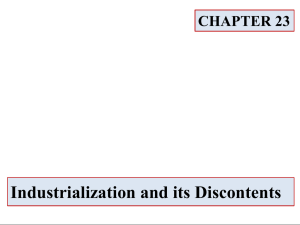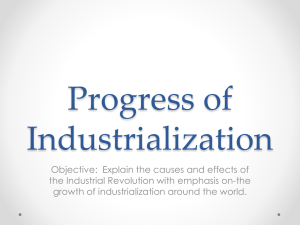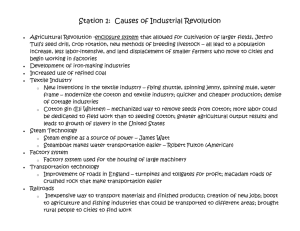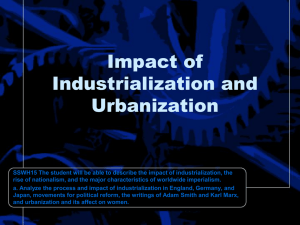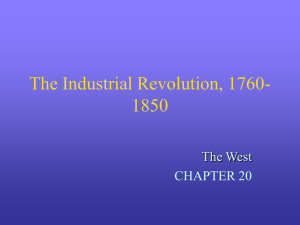Industrialization
advertisement
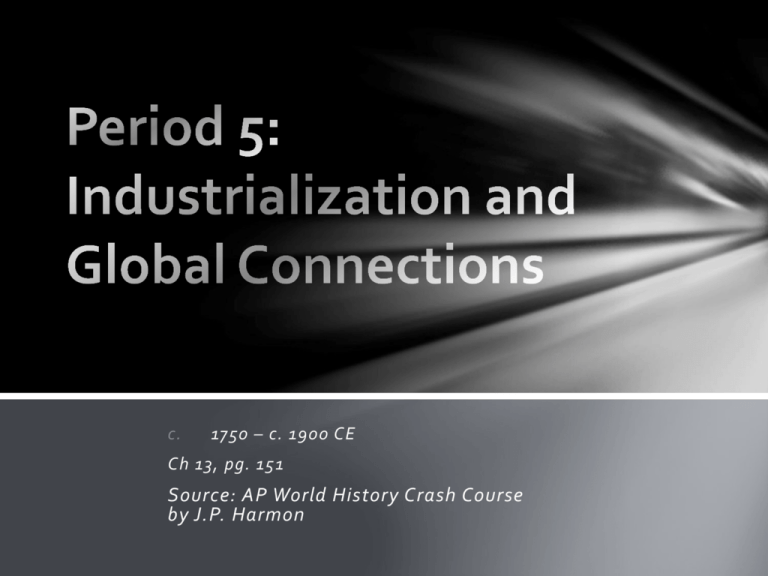
c. 1750 – c. 1900 CE Ch 13, pg. 151 Source: AP World History Crash Course by J.P. Harmon Most dramatic change since the Neolithic Revolution Begins in Britain Western Europe’s governments • Richest in the world (thank you Latin American gold and silver) • $$ invested part of this into prizes to inventors • Resulted in more efficient ways to: • Transport goods • Grow crops • Defeat enemies Geography The right type of natural resources • iron • coal • good soil • fast moving rivers • natural harbors Products exported back to colonial consumers Belgium, Germany, France had similar conditions and soon followed Britain Economic and Social Mobility Social mobility possible with reality of invention • “a nation of tinkerers” Banks loaned $$ (££)to inventors Workforce • Britain had large number of skilled workers familiar with use of metal tools • Contributed to the development of machines • Enclosure Movement forced many farm workers to cities to look for work Why Britain? Why not … anywhere else? ONLY Western Europe had ALL the necessary factors • Incentive • Materials • Skilled labor Africa had more natural resources but not stable governments Ming China strong government and economy but not resources India & China tradition of invention but not the incentive Mechanization of Textile Production Machine to mass produce cloth and thread Faster and cheaper cloth production Machines so large they needed special buildings • factories Waterwheels to provide power The Steam Engine Invented in Britain Made waterpower obsolete • Factories free to be build away from water • Connection to machines made production infinitely better The Steam Engine Technological changes came in rapid succession • Invention of the cotton gin, took cotton production to a new level • Steam boat made sail transportation obsolete • Locomotive Fossil Fuels • Coal was initial fuel • Later on in the 19th century petroleum was used more and more • Development of the internal combustion engine Steel • Advancements in production of steel was lighter, stronger and more flexible • Steel factories centered around iron and coal mines • “king of metals” of the industrial revolution • Great Britain first; US, Japan, Russia to follow Industrialization Spreads: United States • US quick to follow GB with the invention of the cotton gin • Single crop plantations (cotton, tobacco) and slavery flourished • Northeast textile factories; south raw materials production • Railroads Industrialization Spreads: United States South’s loss to North in American Civil War and abolition of slavery turning point in government’s power to encourage industrial build-up Trans-continental Railroad By 1900 US world’s largest steel producer • US Steel world’s 1st billion $ company Industrialization Spreads: Japan • Commodore Perry and the forced opening of Japan to world trade • Japan responded by embracing societal, political and industrial change • Used western technology to specialize in silk textiles • Differing from western: Japanese government heavily involved in industry Industrialization Spread: Russia Russia’s progress NOT like US and Japan– slow to transform to industrialization Russian gov’t primary focus was to support the elite and the use of serfdom Russia frees serfs and seeks foreign investment in industry Becomes the top producer of steel Regardless, Russian economy still more like 15 th century with most peasants still based in agriculture Industrialization Spreads: Latin America European invested in Latin American early industrialization Some railroads were built but LA remained mostly agricultural and serf based • Single crop products: • Coffee • Bananas • Wheat • Beef • sugar Industrialization Spreads: India • England rules India • India leading grower of cotton which England eagerly imported • Some industry in India to create the thread and cloth • But not rapid growth until end of 20 th C Industrialization Spreads: China • Rejected most things Western • Some industry for railroads • Continued with peasant labor and hand-made items • Industrial powers take advantage of China’s weak gov’t and forced open trade regions (spheres of influence) • US proposed “open door policy” Industrialization Spreads: Other Areas Ottoman Empire • Limited progress • Gov’t misread the impact of industry in West Africa • Remained provider of raw materials • Little to no industry allowed Western Europe and the U.S. Rapid changes made in “western” regions affected the economy and everyday life • Movement of workers from rural areas to cites in search of work due to Agricultural Revolution (loss of job) or desire of change Rise of wages caused factory work to be “man’s work” • When factories became more efficient they required fewer workers (women and children no longer needed) • But children still used in agriculture and mining Western Europe and the U.S. Wages rising brings about a new social class • Middle class • Group lies between rich and poor • Always existed but grew exponentially as Ind Rev grew Traditional family structure emerges • Women expected to marry and stay home raising children • Urban families had fewer children that farm families • Single women entered employment as teachers Western Europe and the U.S. Closer to 20th century women began to enter the business world as secretaries and telephone operators • Women allowed to vote only after WWI (1918) • Fewer children required in factories as laborers caused gov’ts in the “west” to establish compulsory education laws Western Europe and the U.S. • Cities developed and grew bigger than ever in history • Mass migration to cities caused deplorable conditions • Overcrowded housing • Pollution • High crime rates • These conditions lead to sweeping changes in gov’t policies Western Europe and the U.S. Art and literature changed as well • Left the Romantic era of art and shifted to Realism • Invention of the camera • Development of artistic style of Impressionism • Deliberately unfocused scenes of nature • Charles Dickens • Oliver Twist • David Copperfield • A Christmas Carol Latin America • Limited impact of Ind Rev • Social structures and gender roles continued status quo • Mass migration of Europeans to Latin America • Japanese immigrants came to western South America as laborers • Global Markets demand machine-made goods • Large banks loan $$ for foreign investments • British East India & Dutch East India – first 2 • United Fruit Corporation - bananas • Exchange of goods & money caused economies to grow fast • Established gold standard for world currencies From Steam to Gas • 2nd half of 19th century pace of advancement sped up • Focus now on gas or diesel engine rather than steam • More inventions related to electrical systems, scientific discoveries and medicine • All inventions could be applied to warfare Communication Invention of the telegraph in 1840s • telegraph cable laid under Atlantic from Britain to North America late 1850s • By 1870s across the Pacific • 1902 entire British Empire connected Telephone in 1876 • Popular because it required no special training and was right there in the home Radio developing Transportation Steam boat and steam train Electric trolley car Subway systems Automobile invented in GERMANY in 1880s • Mostly experimental device Science and Medicine Modern chemistry began in this era • systematic studies of chemical compounds and composition of matter • Developing compounds in labs • Fertilizers Science and Medicine Government oversight of programs to provide citizens with healthier lives • Clean drinking water Advances in medicine • Smallpox and rabies vaccinations • Sterilization of surgical instruments • Use of anesthetics during surgery • Aspirin Science and Medicine Science and Faith cross • Charles Darwin • Natural selection • Humans and apes have similar characteristics • Begun furious debates about the nature of humanity • Survival of the fittest in the animal kingdom transferred to human civilization • SOCIAL DARWINISM • Wherein the superior races must naturally defeat inferior ones

